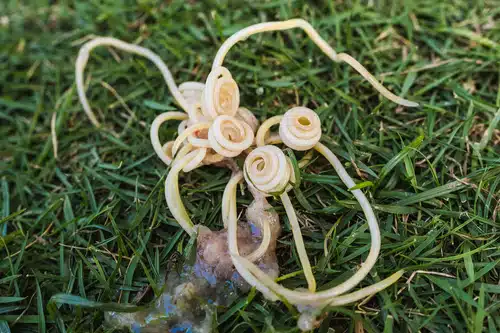Home » Blog » Pet » Pet Health & Safety » Preventing, Identifying and Treating Intestinal Worms in Dogs
Categories
Tags
animal welfare
breed profile
buying a car
buying a pet
Car
car accessories
car care
car features
car insurance
Car safety
car sales
car service
cat
cat behaviour
cat body language
Cat Breeds
cat food
cat insurance
comprehensive car insurance
Dog
Dog Behaviour
dog body language
Dog Breeds
dog food
Dog Insurance
dog training
eco friendly cars
Kitten
New Car
pet accessories
pet activities
Pet Adoption
pet breeders
pet days of the year
pet fun stuff
Pet Health
pet insurance
pet parenting
Pet Safety
pet services
Puppy
rescue pets
road safety
road trip
safe driving
Recent Blog:
Facebook Posts
1 day ago
Growing old sometimes means we can’t take care of pets anymore. Find out some advice on what to do when this happens:![]()
![]() Senior Pet Parents – Contingency Plans for Your Pet – bit.ly/44bzwkS
... See MoreSee Less
Senior Pet Parents – Contingency Plans for Your Pet – bit.ly/44bzwkS
... See MoreSee Less
Senior Pet Parents' Contingency Plans for Pets
www.pd.com.au
Sometimes senior pet parents need more downtime. For older pet owners, this can be tricky to navigate if their dog or cat is full of beans and wants to3 days ago
Before you rev up the engine, let’s run through a checklist of things to do before starting your car. Not only do these steps ensure your safety (and that of others around you), but they also help in maintaining your vehicle's longevity.![]()
![]() Driving Tips: Your Checklist Before Starting Your Car -
... See MoreSee Less
Driving Tips: Your Checklist Before Starting Your Car -
... See MoreSee Less
Driving Tips: Your Checklist Before Starting Your Car
www.pd.com.au
Heading out for a drive? Hold up a second! Whether you're dashing off to work, running errands, or embarking on a road trip adventure, there are a few1 week ago
Are intestinal worms setting up camp in your dog’s gut without paying rent? Here’s how to spot the main culprits and get rid of them too:![]()
![]() Preventing, Identifying and Treating Intestinal Worms in Dogs - bit.ly/43YjCKu
... See MoreSee Less
Preventing, Identifying and Treating Intestinal Worms in Dogs - bit.ly/43YjCKu
... See MoreSee Less
Preventing, Identifying and Treating Intestinal Worms in Dogs
www.pd.com.au
Intestinal worms, such as roundworms in dogs are one of the least glamorous topics on the planet. These intestinal parasites that basically use our dogsIntestinal worms, such as roundworms in dogs are one of the least glamorous topics on the planet. These intestinal parasites that basically use our dogs as their host eco-systems are also one of the least visible pests. In most cases they’re practically too small to see – or they’re hidden.
Long story short, as much as they’re not fun to talk about and we can’t see them, we do see the negative effects they cause dogs. To help give our dogs the soft landing they deserve, this article looks at prevention, treatment and identification of four common intestinal worms in dogs.
Warning: graphic images
Take a look…
In this article

4 common types of intestinal worms in dogs
When it comes to intestinal worms in dogs, there are four main culprits.
In no particular order, here they are:
- Roundworms
- Hookworms
- Tapeworms
- Whipworms
The names of these pesky critters are pretty much basic descriptions of what they look like. In other words, how they’re shaped. Let’s take a closer look at these awful intestinal parasites in dogs…
Pictures of intestinal worms in dogs
Note to squeamish readers, the following pictures and descriptions of intestinal parasites in dogs are gross. We wish they didn’t exist, but they do, so let’s get our knowledge up and tackle them head on.
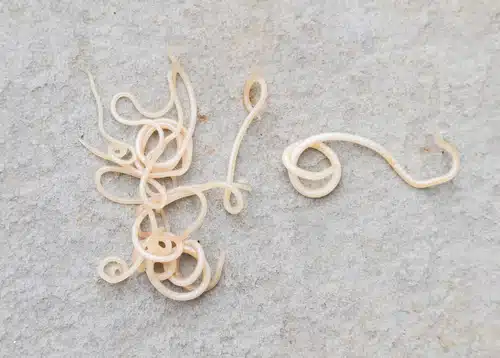
1. Roundworms in dogs
Roundworms are round, a bit like earthworms (but without the good credentials). Like earthworms, they’re also long and stringy but much lighter in colour.
These critters live in a dog or puppy’s small intestine but that’s not all because they get around… Unfortunately roundworm larvae inhabit the liver, moving to the lungs as they develop. Dogs or puppies cough them up but end up swallowing them again and that’s how they get to the intestines where the life cycle starts again.
How do dogs get roundworms?
Dogs and puppies can get roundworm in three ways:
- A puppy can be infected in the womb or through its mum’s milk
- Eating an infected animal, such as a rodent or bird
- Eating roundworm eggs, for example in soil (dogs poop these out and they can be dormant in the environment for years before finding a host)
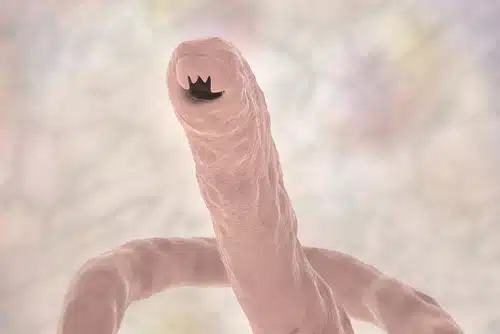
2. Hookworms in dogs
As the name suggests, hookworms have a hooked mouth. They grab hold of the dog’s intestine using these hooks and there they consume a dog’s blood. Much like roundworms in dogs, hookworm larvae live make their way to its lungs where after being coughed up and swallowed live out their adult lives in the intestine.
One unsavoury difference between hookworms and roundworms in dogs is that hookworms spend part of their lifecycle dormant in the muscle tissues. During pregnancy these intestinal worms can become reactivated in the dog. On a lighter note, learn how long dogs are pregnant and read about the dog birth world record.
How do dogs get hookworms?
Dogs and puppies can get hookworms in several ways:
- A puppy can be infected in the womb or through its mum’s milk
- Ingesting eggs, which can lie dormant in the soil from infected dog poop
- Through the skin, like for example, a dog lies on the ground where there are hookworm larvae
- Eating a hookworm host such as a cockroach
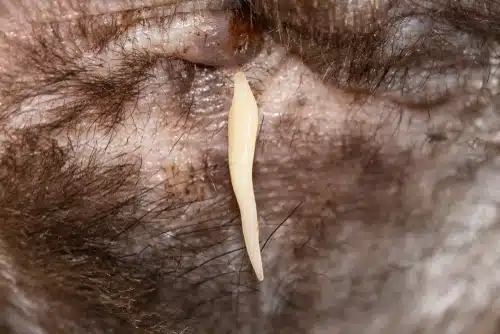
3. Tapeworms in dogs
Before we describe tapeworms in dogs, we’re giving fair warning: hold onto your hats. Tapeworms comprise of multiple segments, kind of like you’d cut when you’re cutting little pieces of sticky tape. Here’s where it gets grim because each segment has its own reproductive tract.
That’s simply and plainly unfair. One worm should only be given one reproductive tract, even if we’re talking black Friday sales. As far as intestinal worms in dogs go, tapeworms clearly skipped the queue and snuck to the front of the line in this department.
How do dogs get tapeworms?
Unlike roundworms and other intestinal parasites, dogs get tapeworms from fleas. Fleas eat tapeworm eggs and dogs accidentally eat the fleas when gnawing at the itch. The tapeworm has succeeded in its nasty plan by entering the dog’s intestine where, it attaches itself to the small intestine.
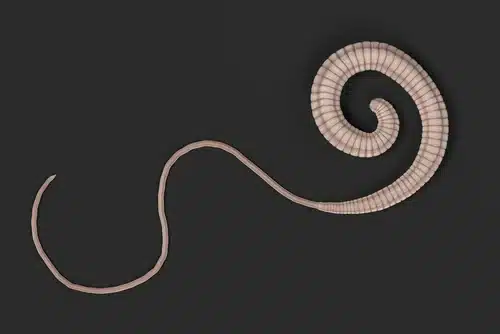
4. Whipworms in dogs
Whipworms lodge their wider head in a dog’s intestinal wall; let’s just say they completely lack any grace whatsoever. The larvae of these intestinal worms spend their time in the small intestine of dogs, moving to the large intestine as they mature.
How do dogs get whipworms?
Whipworm eggs can survive up to five years in the environment. They’re hardy intestinal parasites that inhabit the lower intestine of dogs. To get there, a dog swallows the eggs. Like hookworms and roundworms, the eggs can be in the soil, so a dog that sniffles them up can inadvertently become their host.
Symptoms of intestinal worms in dogs
Intestinal worms in dogs can cause a general deterioration of dog gut health. This can lead to poor overall health and even disease. Let’s look at the symptoms each of these parasites can cause, noting there’s lots of overlap.
- Roundworms
Roundworms in dogs live in the intestine so they can eat the food that their host dog eats. To add to the ick, roundworms in dogs can lay up to 200,000 eggs a day. This can cause a range of symptoms from losing kilos (not in a good way) to getting a pot belly.
Symptoms of roundworms in dogs can also include a poor coat condition and even result in vomiting and diarrhoea. Speaking of, read about other causes of dog vomiting and gastro.
- Hookworms
Hookworms can cause diarrhoea, anaemia and weight loss. As far as intestinal worms in dogs, hookworms can cause such bad blood loss that an infestation can be fatal to puppies. They also release a coagulant while sucking blood that results in intestinal irritation because of continued bleeding even after the hookworm stops feeding.
- Tapeworms
Tapeworms are considered less dangerous than the other common intestinal worms in healthy grown up dogs. However, in puppies, they can be more serious causing anaemia, poor coat quality, intestinal blockage. All of which can affect a puppy’s healthy growth. You might spot small rice grain like segments of tapeworms around your dog’s bottom.
- Whipworms
Like hookworms, whipworms in dogs can cause diarrhoea, anaemia and weight loss. Note that this can become chronic and there may sometimes be blood in the diarrhoea.
Next time you take your pet for their routine check up, ask your vet about any worming advice. Watch this PD Pet Care vlog with Dr Cath Watson for what’s involved in your dog’s routine check up:
How to treat intestinal worms in dogs
Treating intestinal worms is generally about deworming on a routine basis with a dog and puppy worming schedule. Keep in mind intestinal worms in dogs can wreak havoc and intestinal inflammation and irritation can become problems of their own which your vet needs to treat.
That pretty much sums up why routine pet care for your dog or cat are so important, including flea and tick treatment. Especially for puppies whose growth can be negatively impacted by intestinal parasites.
Choose award winning dog insurance
Did you know pet insurance can help you pay for unexpected vet bills, some of which can be staggering. Vet costs aren’t subsidised like human medical care, so having a pet plan can help you cover the gap.
PD Insurance gives you one or more months of FREE pet insurance when you buy online. Click below to start a fuss-free quote today.
Share On:

